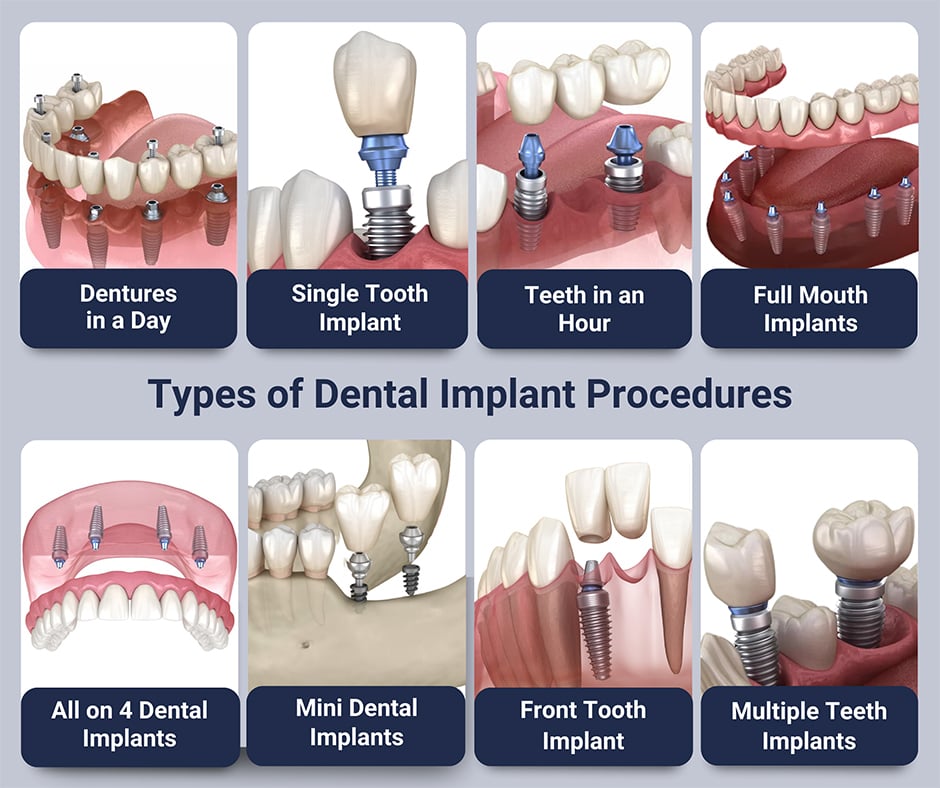Dental Implants Fundamentals Explained
Table of ContentsLittle Known Questions About Dental Implants.Not known Details About Dental Implants The Basic Principles Of Dental Implants 6 Simple Techniques For Dental Implants
are medical gadgets surgically implanted into the jaw to bring back an individual's capacity to chew or their appearance. They provide assistance for synthetic (fake) teeth, such as crowns, bridges, or dentures. When a tooth is lost as a result of injury or illness, a person can experience complications such as fast bone loss, faulty speech, or modifications to chewing patterns that result in pain.
Structure of The Oral Implant System picking dental implants, talk to your dental supplier concerning the potential advantages and risks, and whether you are a candidate for the procedure. Things to consider: Your overall health is an important consider establishing whether you are a good prospect for oral implants, how much time it will require to recover, and for how long the implant may remain in location.
Cigarette smoking may impact the recovery process and lower the lasting success of the dental implant. The healing procedure for the dental implant body might take numerous months or longer, during which time you commonly have a short-term abutment in place of the tooth. the oral implant treatment: Carefully comply with the dental health guidelines offered to you by your oral company.
The Definitive Guide for Dental Implants
Implant failure can lead to the requirement for another medical procedure to deal with or change the dental implant system. Recovers the capacity to eat Restores cosmetic appearance Assists keep the jawbone from reducing because of bone loss Preserves the health and wellness of the bordering bone and periodontals Helps keep nearby (nearby) teeth stable Enhances lifestyle Damages to surrounding all-natural teeth during dental implant placement Injury to the surrounding tissues during surgical procedure, such as sinus opening Injury throughout surgical procedure (for instance, fracture of surrounding jawbone) Poor feature, such as feeling like the teeth do not attack together generally A feeling that the tooth hangs or turning in location resulting from an abutment screw loosening up Implant body failing (looseness of the dental implant body) due to systemic infection, which may be more probable in people with unchecked diabetes because of local infection in bone and gums sustaining the dental implant body due to delayed healing, which might be most likely in patients that smoke Problem cleaning the periodontals around the implant, resulting in poor dental health Untreated periodontal condition Post-surgical tingling as a result of nerve impingement or damage Always alert wellness treatment suppliers and imaging professionals that you have dental implants before any kind of magnetic resonance imaging (MRI) or x-ray procedures.
FDA is not knowledgeable about any type of unfavorable events reported for MRI or x-ray procedures with oral implants. Oral implants systems are generally constructed from materials that follow international consensus requirements of the International Company for Standardization (ISO) or ASTM International. These standards have details of what makes a safe material.
Various other products such as gold alloys, cobalt-based alloys, titanium alloys, or ceramic materials are often used. The safety and security profiles of these materials are well-known. Oral implant systems are evaluated according to global consensus requirements. Biocompatibility testing, to reveal that try this website bodily call with the device does not trigger difficulties like irritability or allergic response, belongs to the assessment that helps make certain the products in the oral implant system are risk-free and do not create negative impacts when dental implanted in individuals.

The 9-Second Trick For Dental Implants
Some individuals are not eligible for oral implant surgical treatment. It is for dental doctors to operate people with: intense illnessuncontrollable metabolic diseasebone or soft tissue condition or infectionIf these problems are settled, a person can have the surgical treatment. Dental Implants. In, oral doctors abstain from running on people with: If individuals with any of the above go through oral implant surgical procedure, there is a greater risk of the dental implant failing
Some individuals have a jawbone abnormality that like it prevents adequate bone for an implant from developing. In such instances, a specialist may need to carry out a ridge alteration. This entails raising the periodontal to expose the location of flawed bone. The doctor will then make use of a bone or bone replacement to fix and accumulate the location.
Dental implant surgery is a customized procedure. It's not the very same for everyone. The adhering to gives a basic review of what you can expect your dental practitioner, you can look here dental cosmetic surgeon, periodontist or prosthodontist to do: Put the implant operatively. Provide you time to recover. Connect the blog post and last crown, bridge or denture.
Next, your cosmetic surgeon will meticulously put the oral implant right into your jaw. Ultimately, your specialist will reposition your gum tissues and shut the incision with stitches. If your dental implant is near the front of your mouth, your dentist will make a short-lived tooth for you to wear up until you heal. This way, you will not have a gap in your smile while you recover.
More About Dental Implants
During the recovery phase, your jawbone needs to fuse to the oral implant. This procedure can take anywhere from three to 9 months.
Once your dental implant heals, your dentist can connect the joint (little connector article) and your final restoration (crown, bridge or denture). This usually takes about one hour to finish and may require a 2nd minor surgical procedure. You should not really feel any type of pain during your dental implant treatment due to the fact that your provider will make use of drug to numb your gums.